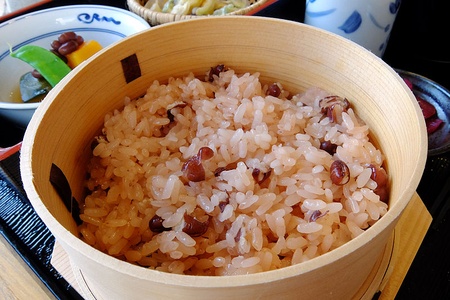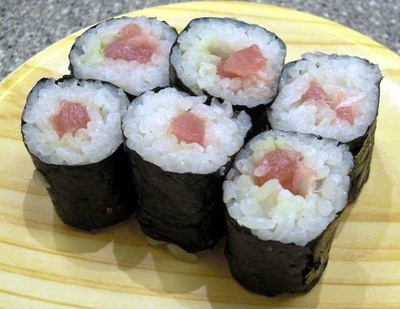These days, it’s easy to find Japanese or Nikkei food in Lima. Perhaps the day when Japanese restaurants are as common as the popular “chifas” (Chinese-Peruvian restaurants), which can be found everywhere, isn’t far off.
Ten years ago, it wasn’t so easy. Much less during the previous century. When Japanese food was still something eccentric in Peru and only known to members of the Japanese-Peruvian community, there were just a few occasions on which a Nikkei could enjoy it. These were special occasions, of course, because it wasn’t something for every day. Like a mass, for example. Or New Year’s Day.
Nowadays, Peru’s Nikkei community celebrates the New Year like other Peruvians: parties, gatherings of friends, camping trips, at the beach, etc. But what was it like before, when the festivities revolved around food?
December 31 was usually a workday, in the time when many Japanese families owned businesses (bazaars, corner stores, restaurants, etc.) In fact, it was a busier workday than usual, because there were so many customers.
The special day was January 1. Preparations for that day included making mochi and cleaning the entire house, so that you could start the New Year with everything clean and tidy.
Japanese families made soba (the length of which was considered a symbol of one’s own longevity) and prepared the osonae, an offering of three mochis for the gods and those who had passed away.
The offering usually included one’s wages or the previous day’s earnings, along with a burning candle, to attract more money in the new year.
The festivities on January 1 included eating mochi and preparing nishime (a special plate with varied ingredients) and ozoni (broth with mochi) for breakfast.
After World War II, these habits changed slightly: families from the community no longer made mochi at home, but ordered it from Japanese bakeries.
As the years passed, the family breakfast was replaced by lunch. This meant preparing dishes reserved for special occasions, such as sekihan or “red rice”. And on the table, mixed with the Japanese food, Western dishes such as roasted duck began to appear.

Visits to friends, not just family, became more common. And no one arrived empty-handed, but with small gifts like tinned preserves, green tea, boxes of ajinomoto seasoning, and bags of shiitakes1.
MEMORIES OF OSHOGATSU
Three Nisei share their memories of celebrating oshogatsu years ago:
Daniel Tagata, who grew up in the city of Callao, recalls: “Thinking back on my childhood experiences around oshogatsu makes me somewhat sad, because when I was four years old (1943) my father’s bazaar was expropriated; Japanese residents who owned property suffered the consequences of World War II. Because he was a community leader, he had to keep a low profile. Without thinking twice about it, my mother took on the responsibility of supporting the family and providing for our education and livelihood for a long time.”
The cleaning ritual for the gods:
“On the 31st (of December) mother made us clean the entire house. We threw out things that were worn or broken because the tradition is to leave everything clean in order to welcome the gods of the New Year. At the end of the day, she made us hot chocolate and we ate panettone. On January 1, she made Japanese food and we all gathered at the table for lunch.”
For his part, Jorge Yamashiro, who also grew up in Callao, remembers: “Our family owned a business on a corner facing Callao’s Central Market (corner of Colón and Cochrane streets), and as was typical in those days, we had the store and a backroom, which was where we ate every day. We also had a loft where we kept the merchandise that came from Japan. Our parents owned a general store, with gifts, food, and other items (decorations, pottery) imported from Japan.”
Jorge Yamashiro remembers that the Japanese residents in Callao came to his parents’ store to buy products and food such as mochi and okashi, and placed special orders for oshogatsu. His family prepared the orders and stored them until the customers came to pick them up.
For children, this time of year was special because they received gifts of money. “We went with our parents to visit family members and we were always excited to receive otoshidama (envelopes with money for the children).’
Akira Fujimoto recalls that Japanese families did not celebrate the New Year on December 31, but on January 1.
“In the morning, when people got up, the first thing they ate was ozoni, a broth with mochi. They always made nishime, a variety of things cooked in broth, depending on what they could get: kamaboko (fish cake), tofu, gobo (burdock root), carrot, turnips; some even added chicken or pork. I also remember eating makizushi. And sashimi. Other people made botamochi, which was mochi rice with anko (bean paste). And red rice for happiness.”

His mother-in-law, a Japanese immigrant, rose early to prepare dishes to offer to the many people, including family members and friends, who came to visit on January 1. The house was bustling all day long, because visitors came at different times. After one group or family left, another one arrived. And that’s how it went. The food had to be heated up over and over again.
Akira Fujimoto remembers that on January 1, married children visited their fathers, who were the heads of the family. That day was also a great opportunity for well-known people in the Japanese-Peruvian community, who had helped or done favors for others, to receive visitors who wanted to show their appreciation. Some people even visited their benefactors every January 1, to thank them for the help they had received.
Note:
1. Source: Toward a New Sun. Fukumoto, Mary.
© 2020 Enrique Higa





